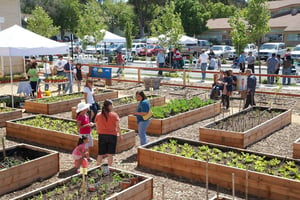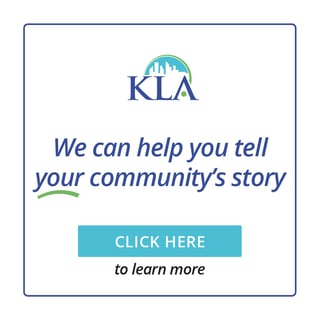This article originally appeared in the American Public Works Association (APWA) publication The Reporter's May 2018 issue.
By: Kim Lundgren of Kim Lundgren Associates and the APWA Center for Sustainability (C4S) and Jennifer Godzeno, Deputy Director at the Participatory Budgeting Project.
Listen to a podcast on the topic of Participatory Budgeting with Kim and Jen.
In Public Works, we often struggle to tell our stories and effectively engage the public,  particularly given the fast pace of our day to day. We are busy answering calls when people have thoughts about potholes, water/sewer service issues, road closures, trees that need to be trimmed, new playground and park equipment and everything in between. Most people in our communities don’t grasp what it takes to deliver all of these services every day, ensure public safety is always the top priority, and fund all of these activities. And if we don’t effectively communicate with and engage the public, we can’t expect them to understand.
particularly given the fast pace of our day to day. We are busy answering calls when people have thoughts about potholes, water/sewer service issues, road closures, trees that need to be trimmed, new playground and park equipment and everything in between. Most people in our communities don’t grasp what it takes to deliver all of these services every day, ensure public safety is always the top priority, and fund all of these activities. And if we don’t effectively communicate with and engage the public, we can’t expect them to understand.
But what if we could give everyone the opportunity to look behind that curtain -- to participate in helping make the tough decisions about what will get funded and what won’t. At a minimum they could appreciate the delicate balancing act we play. And that transparency could help forge a working partnership with constituents as we work together to make our communities better places to live.
That’s where Participatory Budgeting (“PB”) comes in. PB is an open, democratic  process through which community members directly decide how to spend part of a public budget. Participatory Budgeting gives ordinary people real power over real money.
process through which community members directly decide how to spend part of a public budget. Participatory Budgeting gives ordinary people real power over real money.
Started in Puerto Alegre, Brazil, in 1989 and introduced in the US in Chicago two decades later, PB is gaining steam because of the myriad of challenges it addresses and benefits it offers communities large and small, including:
- Building community leaders
- Creating a bottom-up conversation that illuminates a community’s needs and makes local leaders more responsive
- Expanding civic engagement
- Enhancing how informed the public is
- Fostering effective and fair leadership How does it accomplish all of that?
The Participatory Budgeting Project breaks the process down into fives stages:
- Design: A steering committee, representative of the community, creates the rules
 in partnership with government officials to ensure the process is inclusive and meets local needs.
in partnership with government officials to ensure the process is inclusive and meets local needs. - Brainstorm: Through meetings and online tools, residents share and discuss ideas for projects.
- Develop: Volunteers, usually called budget delegates, develop the ideas into feasible proposals, which are then vetted by agency staff.
- Vote: Residents vote to determine how the available budget will be spent to fund proposals. It’s a direct, democratic voice in their community’s future.
- Fund: Winning projects are implemented, such as laptops in schools, Wi-Fi in public parks, or traffic safety improvements. The government and residents track and monitor implementation.
From the point at which a local government thinks “hey, this could work for us” through to actual implementation can feel like an eternity. The planning stage can take 3-6 months followed by 5-8 months for the implementation stages. It involves getting buy-in among the right players and departments internally and externally, determining the budget and scope, identifying a budget and securing funding, and a significant amount of prep work.
So is it worth it?
No longer an experiment, PB is a proven method globally that has been in the US less than a decade and is already showing results. Research by Public Agenda found that “46 jurisdictions across 13 cities in the U.S. and Canada undertook PB between July 2014 and June 2015. During that time, public officials allocated nearly $50 million to PB projects. 73,381 residents voted on 892 projects, and 360 projects won public funding.”
Oakland, California, used PB to help low- to moderate-income communities decide how to to spend almost $800,000 in federally administered HUD Community Development Block Grants. These grants require public participation in deciding how to use the funds, but without PB can be ineffective. In 2017 more than 1,200 Oakland residents voted for projects including meals, mobile showers, and health services for the homeless, housing counseling and legal advice for tenants at risk of eviction, life-skills classes and other support for immigrants and seniors who speak English as a second language, and internship and apprenticeship placement and career counseling for youth.
Greensboro, North Carolina, was the first city in the South to give PB a test run back in 2015-2016. They completed the second PB cycle for 2018-2019 FY funding and are planning a third round. Here are some fast facts from the first PB exercise in Greensboro:
- City Council set aside $500,000 for PB projects, up to $100,000 for each of the five City Council districts
- 1,098 residents engaged, 675 ideas generated online and at over 25 events
- 40 Volunteer budget delegates and facilitators, 28 committee meetings, 2 staff meetings, 1 open house, 10-15 staff reviewers, 75 initial project proposals.
- 200 residents attended 10 Community Expo events; 46 projects for the ballot.
- 1,100 voted at 10 locations and selected 26 winning projects, including murals, crosswalks, road and sidewalk safety features, playground and pool equipment
 Indeed, many of the projects that are funded through PB fall under the Public Works umbrella. In the most recent cycle of PB in New York City, about 40% of the projects funded were for infrastructure improvements and most of the remaining going to schools. Examples abound from coast to coast of PB-funded bike lanes, community gardens, transit upgrades (like bus station shelters or benches), playground equipment, street lights and composting facilities.
Indeed, many of the projects that are funded through PB fall under the Public Works umbrella. In the most recent cycle of PB in New York City, about 40% of the projects funded were for infrastructure improvements and most of the remaining going to schools. Examples abound from coast to coast of PB-funded bike lanes, community gardens, transit upgrades (like bus station shelters or benches), playground equipment, street lights and composting facilities.
You can easily integrate Participatory Budgeting into your current planning and budget processes.
A Few Ground Rules for Participatory Budgeting
- With intentionality, PB advances equity. PB can offer community members something other meeting and engagement processes cannot: a guarantee that your voice will count. The binding vote ensures people will see tangible results, which inspires a more diverse constituency to participate. There are also opportunities at the design, brainstorming and development points of the PB process when community based organizations can be involved and that go beyond a typical advisory role. When cities allow grassroots organizers to play a meaningful role in designing and implementing PB, they can bring in underresourced communities and get diverse perspectives. Indeed, a study by Public Agenda found that PB is reaching historically disenfranchised populations.
- The stakes have to be high enough to matter. PB can be used at the city, county, state or even national scale, but you can also use it at the department level at your city or even a school level. You want to make sure that the money is enough for the stakes to matter and to inspire participation. PBP’s basic rule of thumb is $1M per 100,000 population or 1%-15% of budget.
- Real youth engagement. New York City has successfully incorporated PB for a variety of budgeting processes, and they are making a concerted effort to bring in
 the youth voice. Mayor DeBlasio has pledged to ramp up civics education in schools, including a new pot of funds to expand PB to every public high school as part of an action civics initiative. Harvard University led a study of Boston’s pilot year of the ongoing “Youth Lead the Change” PB process that focuses exclusively on youth 12-25 and found, among other benefits, the empowerment factor and the model of “Change Agent” volunteers. Youth engagement in PB is both valuable -- fresh perspectives, no hidden agendas, and a sense of ownership -- and transformative. If at a young age you learn the skills to engage and see your participation as expected, your community involvement will last a lifetime.
the youth voice. Mayor DeBlasio has pledged to ramp up civics education in schools, including a new pot of funds to expand PB to every public high school as part of an action civics initiative. Harvard University led a study of Boston’s pilot year of the ongoing “Youth Lead the Change” PB process that focuses exclusively on youth 12-25 and found, among other benefits, the empowerment factor and the model of “Change Agent” volunteers. Youth engagement in PB is both valuable -- fresh perspectives, no hidden agendas, and a sense of ownership -- and transformative. If at a young age you learn the skills to engage and see your participation as expected, your community involvement will last a lifetime. - You can’t assign this to an intern. The good news is, you can integrate PB into your current planning and budget processes. PB can streamline the civic engagement work that agencies are and lighten this burden for government staff. But it’s not something you can then offload to an intern -- or even to just one person. Some combination of staff (it is recommended to have the equivalent of 2 full time staff), a volunteer steering committee and community partners much take ownership for the following PB elements: a) Community Outreach & Partnerships b) Group Facilitation & Training c) Volunteer Recruitment & Coordination d) Administrative & Logistical Support e) Budgeting & Technical Support f) Communications & Promotion g) Digital Technology Coordination h.) Research & Evaluation
Additional Resources:
- Listen to the SAS Talk with Kim podcast on Participatory Budgeting featuring this article’s authors, Kim and Jennifer.
- Download the Participatory Budgeting Project’s PB Scoping toolkit and other resources here.
- Follow @pbproject @healthy_planner @thekimlundgren and #participatorybudgeting on Twitter.





